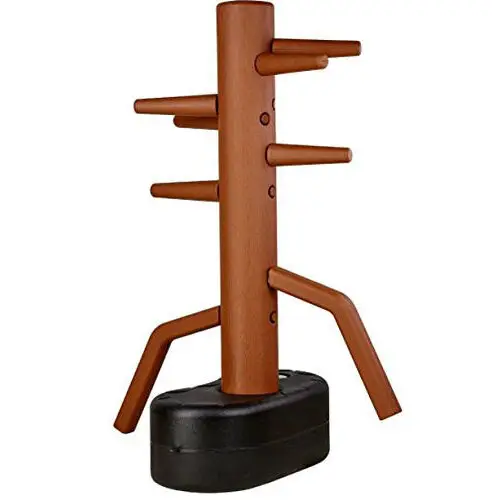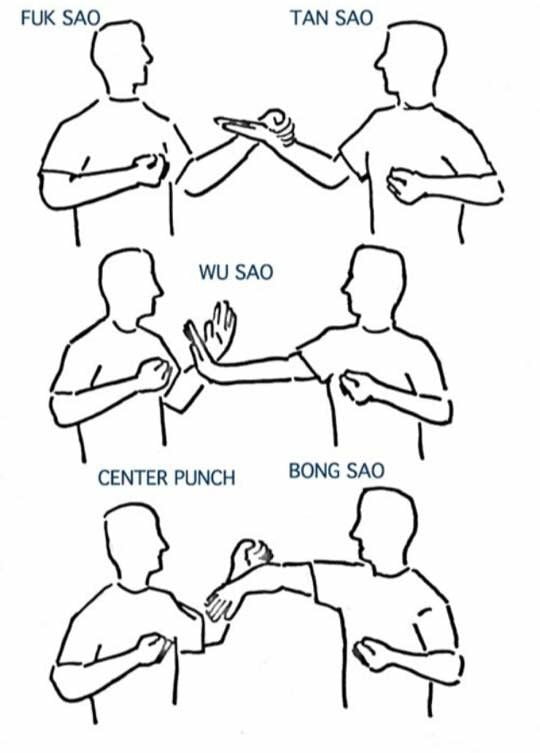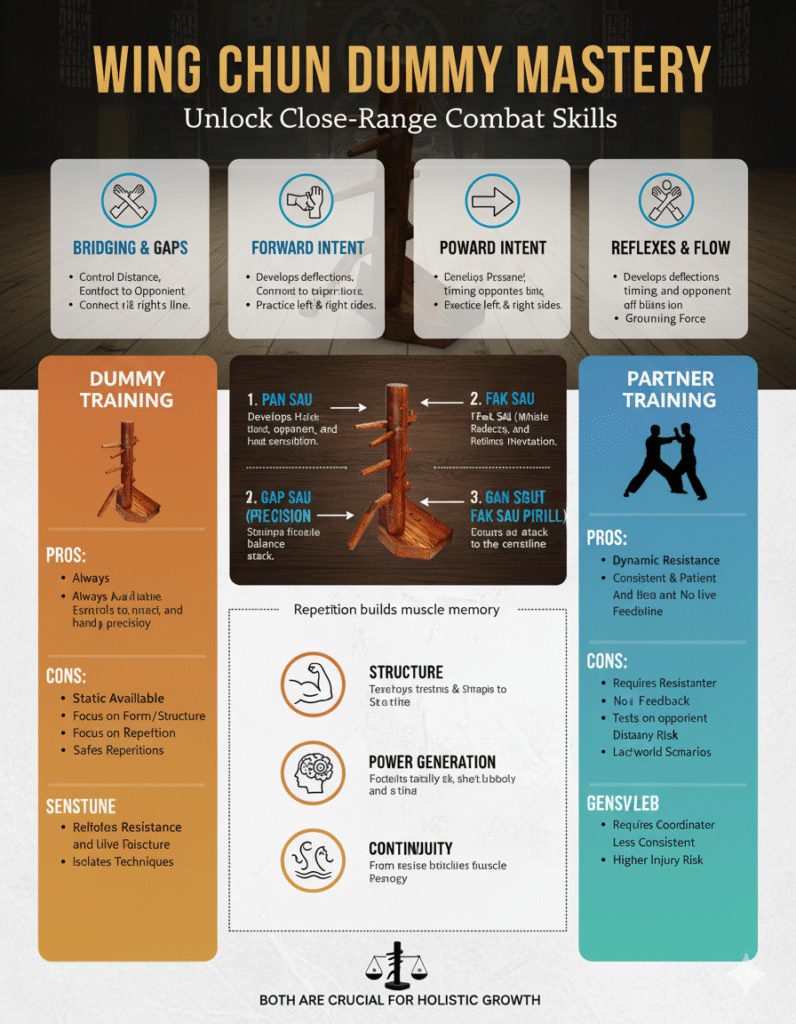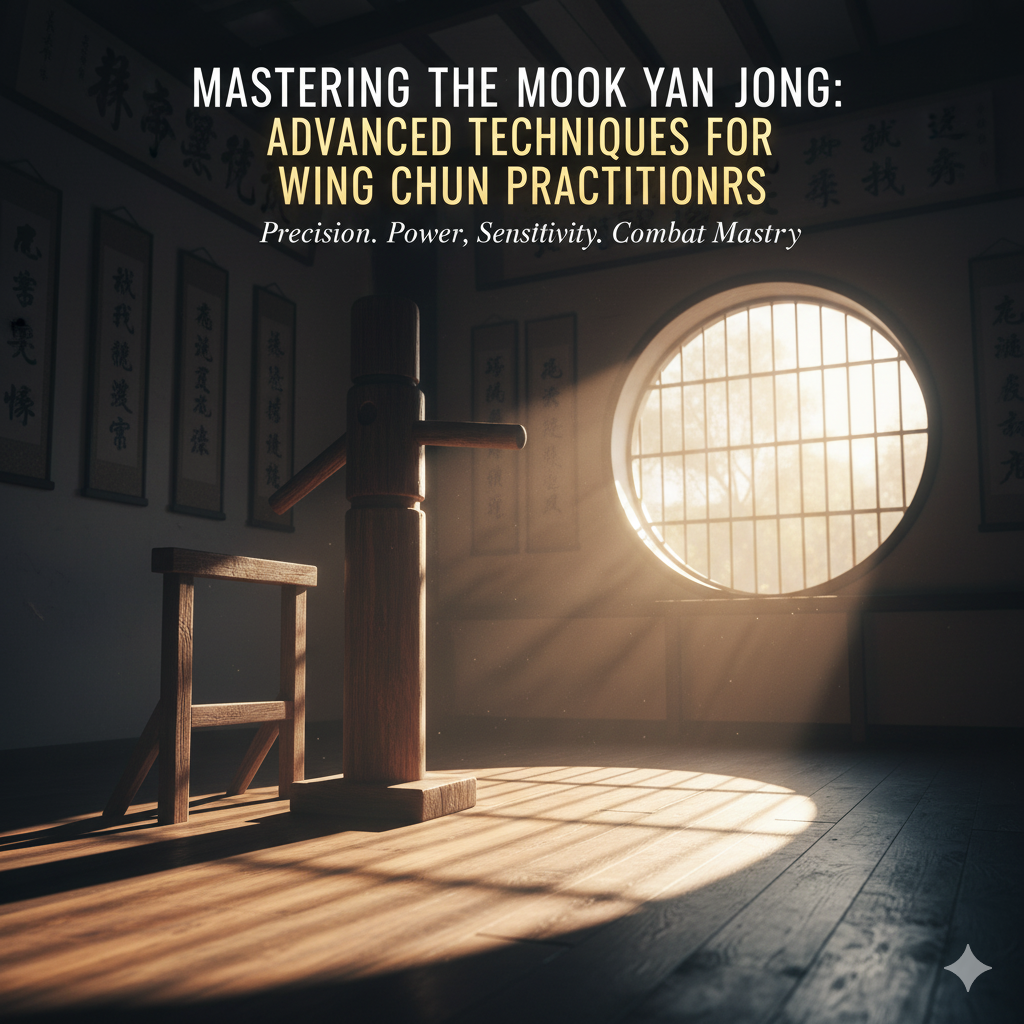Wing Chun Dummy Training
Wing Chun is a traditional Chinese martial art that emphasizes efficiency, directness, and economy of movement.
Originating in the southern Shaolin monasteries, Wing Chun was developed by a Buddhist nun named Ng Mui and later popularized by notable practitioners such as Ip Man and Bruce Lee.
This martial art is characterized by its use of close-range combat techniques, including rapid punches, low kicks, and a focus on centerline theory, which targets the opponent’s central axis.
Central to Wing Chun is the principle of progressive training, which ensures that practitioners build a strong foundation before advancing to more complex techniques.
Training typically begins with basic stances, footwork, and hand techniques, gradually incorporating more sophisticated drills and partner exercises.
This step-by-step approach not only enhances physical skills but also fosters a deeper understanding of Wing Chun’s underlying concepts.
As practitioners progress, various tools and equipment are introduced to refine their skills and simulate real-world combat scenarios.
Among these tools, the wooden dummy holds a special place. Known as the Muk Yan Jong in Cantonese.
the wooden dummy is an iconic training apparatus that embodies the essence of Wing Chun’s principles.
It allows practitioners to practice precise movements, angles, and techniques against a simulated opponent, facilitating the transition from theoretical knowledge to practical application.
The wooden dummy is typically introduced after a practitioner has developed a solid grasp of the foundational forms and techniques.
It serves as a versatile tool for enhancing timing, structure, and energy flow, providing invaluable feedback on the practitioner’s form and alignment.
By integrating the wooden dummy into training, practitioners can fine-tune their skills, improve muscle memory, and cultivate a more intuitive understanding of Wing Chun’s combat strategies.
In this blog post, we will explore the optimal timing for incorporating the wooden dummy into your Wing Chun training regimen.
ensuring that you make the most of this essential tool in your martial arts journey.
Fundamentals Before the Wooden Dummy

In the early stages of Wing Chun training.
practitioners are introduced to the foundational elements that form the bedrock of this martial art.
Mastery of basic stances, hand movements, and footwork is crucial before progressing to more advanced techniques, including the use of the wooden dummy.
These initial stages are designed to build a strong foundation.
ensuring that practitioners develop the necessary skills and muscle memory.
The first fundamental aspect of Wing Chun training is the stance.
The primary stance, known as the Yee Jee Kim Yeung Ma or the “Character Two Adduction Stance,” is pivotal for maintaining balance, stability, and rootedness.
Practitioners learn to align their bodies correctly, distributing their weight evenly and keeping their center of gravity low.
This stance not only provides a solid base for performing techniques but also enhances the practitioner’s ability to absorb and redirect force.
Hand movements are another critical component of early Wing Chun training.
Practitioners begin with basic hand shapes and strikes, such as the Tan Sau, Bong Sau, and Fook Sau.
which serve as the building blocks for more complex techniques.
These hand movements are practiced repetitively to develop precision, speed, and power.
The emphasis is on achieving correct form and structure, which are essential for effective application in combat situations.
Footwork is equally important in Wing Chun, as it enables practitioners to maneuver efficiently and maintain optimal positioning relative to their opponent.
Basic footwork drills, such as stepping, pivoting, and shifting, are practiced extensively to enhance agility and coordination.
Proper footwork ensures that practitioners can maintain balance and stability while executing techniques, making it a vital aspect of early training.
By focusing on these foundational elements, practitioners build a strong base that prepares them for more advanced training.
Mastery of basic stances, hand movements, and footwork ensures that practitioners are well-equipped to progress to the next stage of their Wing Chun journey.
where they can effectively incorporate the wooden dummy into their training regimen.
Introduction to Forms and Techniques
Wing Chun, a traditional Chinese martial art, is systematically structured into three primary forms:
Siu Nim Tau, Chum Kiu, and Biu Ji.
Each form is designed to build upon the foundational techniques and principles established in the previous one, creating a progressive learning journey for the practitioner.
Siu Nim Tau, often translated as “Little Idea” or “Small Thought,” serves as the cornerstone of Wing Chun training.
This initial form focuses on developing proper structure, stance, and basic hand techniques.
It emphasizes cultivating a strong foundation in balance, relaxation, and efficient energy usage.

Mastery of Siu Nim Tau is essential, as it establishes the fundamental principles that underpin all subsequent training.
Chum Kiu, or “Seeking the Bridge,” is the second form in Wing Chun.
It introduces more advanced footwork and body mechanics, teaching practitioners how to generate power through coordinated movements.
Chum Kiu also emphasizes the importance of bridging the gap between oneself and an opponent.
incorporating techniques that facilitate effective close-quarters combat.
By honing these skills, practitioners enhance their ability to maintain balance and control while dynamically engaging with opponents.
Biu Ji, known as “Thrusting Fingers,” represents the third and most advanced form in the Wing Chun system.
This form builds on the principles and techniques learned in Siu Nim Tau and Chum Kiu, introducing rapid, explosive movements and emergency techniques.
Biu Ji focuses on recovering from compromised positions and regaining control in high-stress situations.
It challenges practitioners to refine their precision, speed, and adaptability under pressure.
Proficiency in these three forms is crucial before incorporating the wooden dummy into Wing Chun training.
The wooden dummy, or Muk Yan Jong, serves as a tool to further internalize and apply the techniques learned in Siu Nim Tau, Chum Kiu, and Biu Ji.
By methodically practicing on the wooden dummy, practitioners can enhance their timing, accuracy.
and spatial awareness, ensuring a well-rounded and effective skill set in Wing Chun.
The Role of Partner Drills
Practicing with a partner holds paramount importance in the developmental journey of Wing Chun.
Engaging in partner drills facilitates the honing of sensitivity, timing, and reflexes, which are critical components of martial arts proficiency.
One of the quintessential drills in this regard is Chi Sau, or Sticky Hands.
This exercise emphasizes close-quarters combat and the ability to react to an opponent’s movements with fluidity and precision.
Chi Sau drills are instrumental in fostering an understanding of the dynamic application of Wing Chun techniques.
By adhering to the principles of contact reflexes and tactile sensitivity, practitioners can better anticipate and counteract their partner’s actions.
These drills simulate real-world scenarios where spontaneity and adaptability are essential, thus transitioning theoretical knowledge into practical execution.
The interaction between partners during these drills helps in cultivating a deeper comprehension of the body’s mechanics and energy flow.
This mutual engagement allows practitioners to explore and rectify their weaknesses, thereby sharpening their defensive and offensive strategies.
Through repetitive practice, individuals develop an intuitive grasp of distance, timing, and rhythm, which are indispensable in mastering Wing Chun.
It is generally recommended that practitioners gain a substantial amount of experience with partner drills before incorporating the wooden dummy into their training regimen.
The foundational skills acquired through exercises like Chi Sau lay the groundwork for effectively utilizing the wooden dummy.
This traditional apparatus serves as an invaluable tool for further refining techniques.
but its benefits are maximized when a practitioner already possesses a solid base of sensitivity and timing.
Therefore, the role of partner drills cannot be overstated in the context of Wing Chun training.
They not only enhance the physical attributes required for combat but also instill a deeper understanding of the art’s principles.
By prioritizing partner drills early in the training process.
practitioners can ensure a more comprehensive and effective progression when eventually integrating the wooden dummy into their routine.
Introduction to the Wooden Dummy

The wooden dummy, or Muk Yan Jong, holds a significant place in the practice of Wing Chun, a traditional Chinese martial art.
Historically, the wooden dummy dates back to the Shaolin temples, where it was using as a training apparatus.
Wing Chun practitioners have since adopted and refined its use, making it an integral component of their training regimen.
Structurally, the wooden dummy is designe to mimic a human opponent.
It typically consists of a cylindrical wooden body with three protruding arms and a leg.
This configuration allows practitioners to simulate various combat scenarios.
Practicing techniques such as blocking, striking, and deflecting, in a controlled environment.
The arms and leg are strategically positioned to represent an opponent’s limbs.
offering a realistic training experience that enhances a martial artist’s reflexes, precision, and timing.
The Muk Yan Jong form is a sequence of movements specifically devise for training on the wooden dummy.
This form incorporates a comprehensive range of techniques, from basic strikes to complex defensive maneuvers.
By practicing the Muk Yan Jong form, Wing Chun practitioners can refine their skills, improve their structural alignmen.
and develop a deeper understanding of body mechanics.
The form also serves as a bridge between theoretical knowledge and practical application.
allowing students to internalize principles in a tangible way.
In essence, the wooden dummy is not merely a training tool but a critical element in the mastery of Wing Chun.
Its historical significance, coupled with its practical application.
underscores its value in the martial arts community.
As practitioners continue to explore its potential.
the wooden dummy remains a cornerstone of effective Wing Chun training, embodying the art’s rich heritage and enduring relevance.
Transitioning to Wooden Dummy Training
Recognizing the appropriate time to incorporate the wooden dummy into your Wing Chun training is essential for maximizing its benefits.
The wooden dummy, or Muk Yan Jong, serves as a critical tool that bridges the gap between solo practice and real-world application.
Before transitioning to this advance phase, practitioners should exhibit proficiency in several key areas.
First and foremost, a solid foundation in the basic forms of Wing Chun is indispensable.
Mastering the Siu Lim Tao, Chum Kiu, and Biu Gee forms provides the necessary groundwork for understanding the principles and movements that will be refined on the wooden dummy.
These forms should execute with precision, fluidity, and a deep comprehension of their underlying concepts.
Additionally, a good understanding of partner drills is crucial.
Practitioners should be comfortable with Chi Sao (sticky hands) exercises and other interactive drills that enhance sensitivity, timing, and reflexes.
These drills cultivate the ability to read an opponent’s energy and respond appropriately — skills that are further honing through wooden dummy training.
Another sign of readiness is a solid grasp of Wing Chun principles, such as centerline theory, economy of motion, and simultaneous attack and defense.

The wooden dummy embodies these principles, providing a tangible framework for practicing and internalizing them.
By engaging with the wooden dummy, practitioners can refine their techniques.
The wooden dummy’s design allows for the simulation of an opponent’s limbs and body, offering a unique opportunity to practice angles, distances, and positioning.
This transition from solo practice to a more interactive form of training helps practitioners develop muscle memory and adapt their techniques to various scenarios.
In essence, the wooden dummy serves as a bridge.
connecting theoretical knowledge with practical application, and preparing practitioners for real-world encounters.
Benefits of Wooden Dummy Training
Integrating the wooden dummy into Wing Chun training offers a myriad of benefits that can significantly enhance a practitioner’s martial arts proficiency.
One of the primary advantages is the improvement of structural integrity.
The wooden dummy’s design encourages students to maintain proper body alignment and posture.
which is crucial for effective Wing Chun techniques.
By repeatedly practicing movements against the dummy, practitioners can fine-tune their stances.
and ensure that their forms are strong and stable.
Precision is another key area enhance through wooden dummy training.
The fixed nature of the dummy allows martial artists to focus on the accuracy of their strikes, blocks, and deflections.
The repetitive nature of the drills helps to engrain precise movements into muscle memory.
which is invaluable during real-world applications.
This precision is not easily achieving through solo practice or partner drills.
making the wooden dummy an indispensable tool in a Wing Chun practitioner’s arsenal.
Moreover, training with the wooden dummy aids in developing power.
The resistance provide the dummy’s wooden arms and legs helps to build the necessary force behind each technique.
Over time, consistent practice can lead to increased strength in striking and blocking.
thereby enhancing the overall effectiveness of the martial artist’s skills.
This aspect of training is particularly beneficial for refining the explosive power essential in Wing Chun.
Coordination is also significantly improve through wooden dummy training.
The complex sequences of movements required when working with the dummy necessitate a high level of synchrony between various parts of the body.
This holistic approach ensures that practitioners develop a well-rounded skill set.
integrating both upper and lower body techniques seamlessly.
Another notable benefit is the wooden dummy’s ability to simulate an opponent in a manner that solo practice or partner drills cannot.
The dummy’s structure provides a consistent and unyielding opponent.
enabling practitioners to practice their techniques in a more realistic and dynamic environment.
This aspect of training helps to bridge the gap between theoretical knowledge and practical application.
ensuring that techniques are not only learning but also internalizing.
Overall, the wooden dummy serves as a multifaceted training tool that enhances structure, precision, power, and coordination.
while also providing a realistic opponent simulation.
These benefits collectively contribute to a more refined and effective Wing Chun practice.
Integration of Wooden Dummy Practice into Regular Training
Incorporating wooden dummy practice into your Wing Chun training routine can significantly enhance your skills and understanding of the art.
To achieve a balanced development.
it is crucial to integrate this practice methodically.
Start by dedicating specific days and times to your wooden dummy training.
A common recommendation is to practice with the wooden dummy two to three times a week.
allowing sufficient time for your body to adapt and absorb the techniques without overtraining.
Each wooden dummy session should ideally last around 20 to 30 minutes.
This duration is sufficient to focus on key areas without causing fatigue.
It is essential to concentrate on quality over quantity.
ensuring that every movement with precision and intent.
Begin your sessions with a warm-up to prepare your muscles and joints.
followed by a focused practice on particular sequences or techniques.
Gradually increase the complexity and speed of your movements as you become more proficient.
To maximize overall progress in Wing Chun.
it is beneficial to combine wooden dummy training with other forms and drills.
For instance, after completing your dummy practice.
you can transition into practicing Siu Nim Tau or Chum Kiu forms.
This combination allows you to apply the principles learned on the dummy to empty-hand techniques.
reinforcing your muscle memory and coordination.

Additionally, incorporating partner drills can provide a more dynamic training experience.
Techniques practice on the wooden dummy applies in chi sao (sticky hands) exercises or sparring drills with a partner.
This approach helps in understanding the practical application of techniques in real-time scenarios.
enhancing your reflexes and adaptability.
Finally, it is important to regularly assess and adjust your training routine. Reflect on your progress.
identify areas that need improvement.
and adapt your wooden dummy practice accordingly.
By integrating wooden dummy practice into your regular training with a structured and balanced approach.
you can achieve a comprehensive development in your Wing Chun journey.



